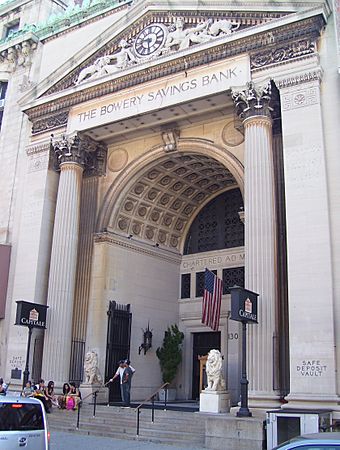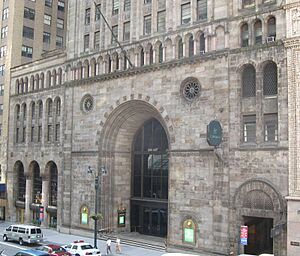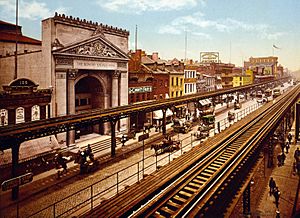Bowery Savings Bank facts for kids
|
Bowery Savings Bank
|
|

Original headquarters, designed by Stanford White
|
|
| Location | 130 Bowery, Manhattan |
|---|---|
| Built | 1893–95 |
| Architect | Stanford White |
| NRHP reference No. | 80002672 |
Quick facts for kids Significant dates |
|
| Added to NRHP | April 23, 1980 |
The Bowery Savings Bank was an important bank in New York City. It started in May 1834. Today, it is part of Capital One Bank.
Contents
A Look Back: The Bank's History
The Bowery Savings Bank first opened its doors in 1834. Its first location was at 128-130 Bowery in Manhattan. By 1980, the bank had grown quite a lot. It had more than 35 branches. These branches were spread across the boroughs of Manhattan, Brooklyn, and Queens. They also reached into Nassau and Suffolk counties on Long Island.
Changes and New Owners
In the 1980s, new rules for banks came into play. This meant the Bowery Savings Bank started to lose money. They had to pay more interest on savings accounts. By 1982, the bank was running low on cash. In 1985, the Federal Deposit Insurance Corporation (FDIC) helped sell the bank. It was bought by Richard Ravitch and others for $100 million.
Later, in 1992, the bank was sold again. This time, H. F. Ahmanson & Co bought it for $200 million. Just three years later, in 1995, Ahmanson sold its New York banks to Greenpoint Savings Bank. The bank continued to change hands. By 2004, Greenpoint was sold to North Fork Bank. Finally, in 2007, North Fork was sold to Capital One Bank. This is how the Bowery Savings Bank became part of Capital One today.
Famous Spokesperson
From 1972 to 1992, a very famous person worked with the bank. Joe DiMaggio, a baseball Hall-of-Famer, was the spokesman for the Bowery Savings Bank.
Key Dates for the Bank
Here are some important dates in the bank's history:
- May 1, 1834 – The Bowery Savings Bank officially started.
- October 22, 1920 – The bank grew by taking over Universal Savings Bank.
- February 14, 1949 – North River Savings Bank joined with Bowery Savings Bank.
- February 11, 1980 – Equitable Savings & Loan Association became part of the bank.
- October 1, 1985 – The bank merged with The State Bowery Savings Bank.
- April 20, 1992 – The bank's name changed to Home Savings of America, Bowery Division.
- September 1, 1992 – It became a Federal savings bank.
Amazing Bank Buildings
The Bowery Savings Bank had some truly beautiful and important buildings.
The First Headquarters: 130 Bowery
The bank's main building at 130 Bowery is between Broome and Grand Streets. It was designed by Stanford White. He was a famous architect from the firm McKim, Mead & White. The building was finished between 1893 and 1895. It is shaped like an "L" and goes all the way to Elizabeth Street. It even has another entrance at 228 Grand Street.
White chose a Roman classical style for this building. This was a new idea for banks at the time. It soon became a popular style for bank buildings across the United States. The outside of the building has tall Corinthian columns. It also features beautiful sculptures by Frederic MacMonnies.
Inside, the building feels like an ancient Roman temple. Many people say it is one of the most amazing spaces in New York. It uses a lot of marble. The teller counters are made of yellow Siena marble. The walls and mosaic floors are also marble. White also used fake marble columns called scagliola. The ceilings have a special pattern, and the stairs and skylights are made of cast iron.
The outside of this original building became an official city landmark in 1966. The inside was also named a landmark in 1994. It was added to the National Register of Historic Places in 1980. Today, this grand building is called "Capitale." It is a restaurant, night club, and event space. It is a very popular place for weddings. In 2012, the building next door at 124 Bowery also became a landmark. It was designed by York & Sawyer and finished in 1902.
The Second Headquarters: 110 East 42nd Street

The bank decided to move its main office in 1920. A new building was built from 1921 to 1923. This new location was at 110 East 42nd Street. It is between Park and Lexington Avenues. It is also right across from Grand Central Terminal in Midtown Manhattan.
This building was also designed by York and Sawyer. They used an Italian Romanesque Revival style. The inside is huge! It is 65 feet high, 80 feet wide, and almost 200 feet long. It uses marble, limestone, sandstone, and bronze screens. This makes the space feel like a grand basilica. People have called it "one of the great spaces of New York." A six-story addition was built next to it from 1931 to 1933. This part was even called "The Chapel."
This building became a New York City landmark in 1996. Today, the ground floor is a Cipriani restaurant. It is also a fancy event space.
Hidden Treasures: Bank Archives
In April 2019, something exciting happened in Brooklyn. Workers cleaning a basement found very old records from the Bowery Savings Bank. These records were about 100 years old! Experts quickly worked to save as many of these records as possible. No one knew right away how important they were. But a historian told The New York Times that they "could be priceless."
A writer named Henry Miller even wrote about the architecture of this bank in the 1920s. He called his short text A Bowery Phoenix.
Images for kids
See also
 In Spanish: Bowery Savings Bank para niños
In Spanish: Bowery Savings Bank para niños








